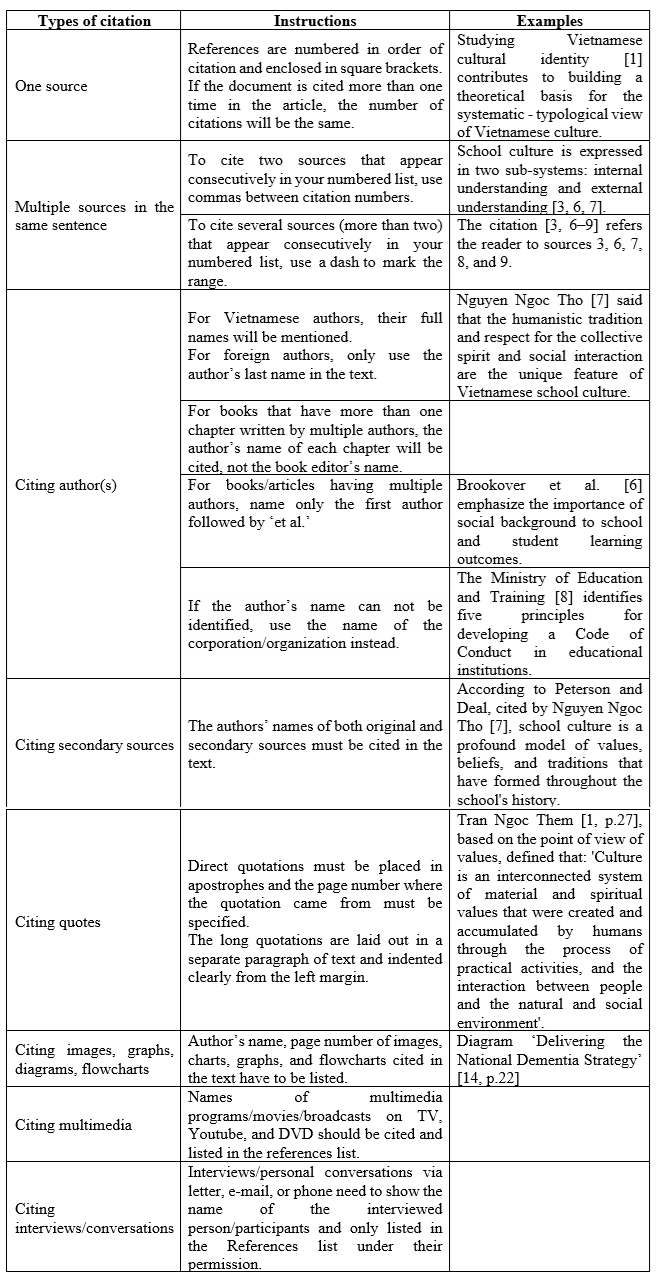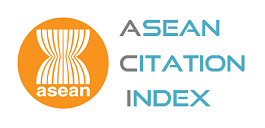MANUSCRIPT FORMATTING GUIDE
1. General requirements
Tra Vinh University Journal of Science publishes original research and review articles in both Vietnamese and English submitted by national and international researchers, including articles in the fields of technology, agriculture, fisheries, economics, social sciences, education, medicine, environment, culture studies, literature, and arts.
Manuscripts submitted to the Journal must not have been published earlier in any other journal and must not be considered for publication elsewhere.
Manuscripts must be submitted to the Journal via the online system at http://journal.tvu.edu.vn. Any articles submitted via e-mail will not be accepted. Authors can be required to adjust their manuscripts’ content and formatting before being formally received.
The manuscript should be written using Microsoft Word with the following formatting: page size is A4; font is Times New Roman; font size is 12 pt; line spacing is exactly 16 pt; margins are 2.5 cm at the top, 2.0 cm at the bottom, 3.5 cm on the left, and 2.0 cm on the right. Research articles must be from 08 to 12 pages and review articles must be from 12 to 25 pages.
2. Manuscript structure
The manuscript should consist of following parts: Title; Author(s); Corresponding author and Affiliation; Abstract; Keywords; Introduction; Literature review; Research methods; Results and Discussion; Conclusion; Acknowledgement (if any); and References; None of footnotes or appendices is required.
Note: Abstract, Acknowledgements, and References sections are not numbered sequentially, while the Introduction, Literature review, Research methodology, Results and Discussion, and Conclusion section are numbered in sequence using Roman numerals (I, II, III…). Section titles must be capitalized and centered.
3. Manuscript formatting guide
Title
- In uppercase and bold.
- Title should be written briefly, clearly, sufficiently, and describe the research contents.
- Scientific names are in italic.
- Abbreviations within the title must be avoided.
Author(s), Corresponding author, and Affiliation
- Write full name of all authors, for Vietnamese authors using their full names without tone marks, omitting author’s academic titles and positions.
- For affiliation, use superscript (by numerical order) right after author’s name for annotations.
- For corresponding authors, use asterisk (*) as a superscript right after author’s name, providing e-mail address.
Abstract
- Briefly describes the research purpose, methods used, major findings, conclusion, and significance of the study.
- Should be italicized and no more than 250 words.
- Does not use abbreviations or citations.
Keywords
- The article should include 03-06 keywords.
- Author should avoid keywords that are vague and polysemantic.
- Keywords are italicized, in bold, not capitalized and separated by commas.
- Keywords are arranged in alphabetical order.
I. INTRODUCTION
- Briefly describes the background, the importance, the aim and novelty of the research.
- Avoid stating details or contents that are not relevant to the research
II. LITERATURE REVIEW
- Generalizes the scientific works directly related to the research.
- Evaluates the current state of research issue, identifies the achievements and limitations in the research field that need to be supplemented and perfected.
- Shows new contribution of the work to the research gap in the field as well as to scientific development.
III. RESEARCH METHODS
- Reviews research design, research object, research location and time, sample size and sample selection, research tools and techniques of data collection, and data analysis in enough detail so that other researchers can apply the methods in future studies.
- If the study uses methods published in other studies, the sources should be cited and described, including any adjustments that were made.
IV. RESULTS AND DISCUSSION
- Presents the results and findings of the study which answer the research questions.
- Should present important results in a logical order.
- Needs to be explained briefly, honestly, clearly, and coherently, not simply repeating the data in tables and figures.
- Discusses, explains and compares with the results of the previous studies mentioned in the Literature Review.
- States the limitations of the study.
V. CONCLUSION
- Crucial conclusions should be stated with clear arguments on the basic of the results.
- It is necessary to state the significance of the study in relation to previous studies and propose how future scholars can extend the research or practitioners can apply the research findings.
- The results of the study do not need to be repeated.
Acknowledgements
- This section is to thank the organization(s) and individual(s) that funded the study or provided financial or technical support to the author(s), to thank the colleague(s) who have contributed to the article or research, and/or to thank the research subjects who have participated in the study.
- Names of organizations and individuals to be acknowledged must be written in full.
Abbreviation
- Abbreviations only used when they appear at least twice in the text.
- Each abbreviation must be defined at its first appearance, then it is written consistently throughout the text.
Tables, images, diagrams, graphs
- Tables and figures are clearly presented, are easy to read, and are numbered consecutively in ascending order (e.g., Table 1, Table 2...; Figure 1, Figure 2...)
- Images, charts, graphs, maps, flowcharts, etc., collectively referred to as figures, are formatted in *.JPG, *.PNG, *.GIF, *.TIFF, *.BMP, *.EPS or vector formats.
- Table captions should be placed above the table, centered, lowercase, capitalized in the first letter, and without a full stop at the end of the line.
- The figure caption is placed below the figure, centered, lowercase, capitalized the first letter, and without a full stop at the end of the line.
- Tables and figures originating from other sources must be cited. Citations are placed at the bottom of the tables or figures, in brackets, italic, and listed in references.
- For example:
Table 1: Average growth of GRDP by regions in the period 1995-2018


Fig. 1: Lorenz curve of the intermediaries in the shrimp market in the Mekong Delta [47]
Units:
- Length, area, volume: mm, cm, km, mm2, cm2, m3, µL, mL, L…
- Weight: g, kg, ng, µg, mg, kg, t, Da, kDa…
- Concentration: nM, µM, mM, M, µg/L, mg/L, g/L…
- Add space between the number and the unit (for example 8 L, 8 kg, 8 ppm…), except percentage unit (%) and temperature (°C, °F) (for example 5%, 60°C).
Numbers:
- In English: use periods to indicate the decimals and use commas to separate thousands.
- The method of using decimals is based on the measurement level of the research method.
Scientific names:
- Written in italics, fully in the title and the first appearance in the text, then abbreviated consistently throughout the article. For example, Escherichia coli is fully written in the first appearance and E. coli since the second appearance.
Math formulas:
- Written in a separate line and centered.
- Use Equation tool in MS Word or MathType for writing formulas.
In-text citations:
- In-text citations are formatted as detailed in Table 2.
Table 2: Citations formatting

List of references:
- References list should include only sources cited in the article.
- It is not acceptable to use footnotes to replace the reference list.
- References are formatted according to Vancouver Citing and Referencing Style (Imperial College London, version 2023) and adjusted to the reality of Vietnamese scientific works published in Vietnam. For instance:
+ For Vietnamese authors, (1) for scientific works published in Vietnamese, author’s full name will be mentioned (e.g. Pham Cu Thien), (2) for internationally published scientific works, author names are written as they appear in their publication (e.g. Tran ND, Bao-An Nguyen).
+ For foreign authors, author citations start with the family name, then the first letter of the first name and, if available, the first letter of the middle name (e.g. Simons NE; Matthews A).
- References list should appear at the end of the article with the title “REFERENCES” and centered.
- References are listed in Arabic numerals, numbers are enclosed in square brackets, e.g. [1], [2], [3] and must be compatible with the numbers of citations in the text.
- For personal communications:
+ Interviews should be cited and listed in the reference list;
+ Letters, e-mails, and phone calls should not be listed, unless you have permission from the sender and receiver to include their details in your reference list.
- Each type of source such as: journal article, book, book chapter, e-book, or conference proceedings must follow its own formatting rules using Vancouver style.
- For sources that have more than six authors, only six first authors will be listed, and add “et al.”
- For sources in other languages (Latin and non-Latin alphabet languages), at least the original title must be mentioned.
Table 3: References formatting

>> Article template TVUJS: Download
>> Article template TVUJS (Vi): Download
>> 2025 Manuscript formatting guide: Download










